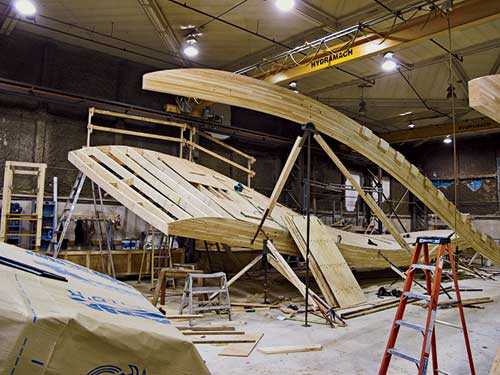Wood's New Wave
Although such complex building forms have been accomplished with concrete and steel, Vancouver-based Fast + Epp, the structural-engineering firm that worked on the visitor center, believes this is the first time one has been created out of wood. According to Duane Palibroda, managing associate of Fast + Epp, the form could not have been achieved without current 3-D computer-aided-design (CAD) technology.
 |
|
Using computer-modeling software, the team transmitted the final design directly to the fabricator's shop-drawing program, which in turn controlled the machines that accurately produced the complex components. Image courtesy Perkins Will |
Time was a critical factor in the construction of the visitor center because of stipulations by one of the project's sources of funding, so the roof had to be fabricated while concrete was being poured on-site. The only way to do this was to build the roof in an off-site shop in separate sections and then transport the components to the site for assembly.
According to Palibroda, the prefabricated panel dimensions were based on the maximum 3.6-by-18-meter dimension that a flatbed trailer could easily transport to the site. Each panel's location then determined its unique size, the profile of the curved glulam beams that would form the sides of the panel, and the necessary locations of the support columns relative to the architectural layout below. The profile of each unique beam was then forwarded to the glulam supplier for fabrication. These, in turn, were shipped to the panel fabricator.
The appropriate pairs of glulam edge beams were positioned in the shop to become the jig for a particular panel, which was then interconnected with the sawn-timber joists, and sheathed on the top face with plywood. Once the structural frame of the panel was completed, it was fitted with thermal insulation, sprinkler pipes, lighting conduits, acoustic liner, and wood ceiling slats. After being transported to the site, the 71 trapezoidal-shaped panels were lowered and bolted to prefabricated glulam columns using a novel universal connection designed to accommodate the uniqueness of every support condition. FSC-certified Douglas fir was used predominantly to fabricate many of the wood components of the roof structure.
Completed in August 2011, the project has earned a LEED Platinum rating and is seeking Living Building Challenge (LBC) certification. According to Perkins+Will, the total wood in the visitor center sequesters enough carbon to offset that generated in the construction of the entire building—one of the goals of LBC.
Mass-Timber Construction
As impressive and advanced—aesthetically, technologically, and environmentally—as the VanDusen visitor center's roof is, the structure still fundamentally relies on the conventional stick- or light-framing method of wood construction. In contrast, a very new method of construction with engineered wood has recently emerged that proponents believe has the potential to completely reshape the construction industry, including slashing its large contribution to greenhouse-gas emissions. Generally referred to as “mass-timber” construction, this approach began in Europe about 20 years ago, caught on in Canada about five years ago, and is beginning to be explored in the U.S.









